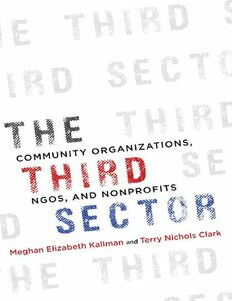
The Third Sector: Community Organizations, NGOs, and Nonprofits PDF
Preview The Third Sector: Community Organizations, NGOs, and Nonprofits
The Third Sector The Third Sector Community Organizations, NGOs, and Nonprofits MEGHAN ELIZABETH KALLMAN TERRY NICHOLS CLARK With assistance from CARY WU and JEAN YEN-CHUN LIN University of Illinois Press URBANA, CHICAGO, AND SPRINGFIELD © 2016 by the Board of Trustees of the University of Illinois All rights reserved C 5 4 3 2 1 This book is printed on acid-free paper. Library of Congress Control Number: 2016948563 ISBN 978-0-252-04043-6 (hardcover) ISBN 978-0-252-09885-7 (e-book) This book is dedicated to the activists, volunteers, and employees that comprise the third sector worldwide. Contents List of Illustrations Acknowledgments Introduction: Democratic Governance and Institutional Logics within the Third Sector (or, How Habermas Discovered the Coffee House) 1.Civil Society, Social Capital, and the Growth of the Third Sector 2.The United States 3.France 4.Japan 5.South Korea 6.Taiwan 7.China 8.Looking Forward: Understanding Associations and Trust Patterns Conclusion: Global Themes References Index List of Illustrations Figures 1.Average years of total schooling for individuals aged 15+ in selected countries, 1950–2010 2.Factors contributing to the rise of the New Political Culture 3.Source of third sector contribution to GDP vs. other factors in seven countries 4.Civil society organization workforce as a share of the economically active population, by country, 1995–2000 5.Employment in the nonprofit sector vs. selected industries, 2010 6.Nonprofit employment, 45 states and District of Columbia, by field, 2010 7.Comparison of attitudes toward capitalism and the market economy in six nations 8.Source of civil society organization revenue in South Korea 9.Expenditures for Children Are Us Foundation 10.Income for Children Are Us Foundation 11.Founding year of associations in nine selected regions of China 12.The development of associations in China, 2001–2010 13.The development of foundations in China, 2001–2010 14.National giving levels as percentage of GDP 15.Chinese philanthropy development, 2011 16.Number of Chinese Internet users and Internet penetration rate, 2004– 2011 17.Registered governmental Weibos, 2012 18.Membership in associations in the six profiled countries, as a percentage of total population 19.Variations in cultural activities, 1981–2000 20.Total organizations by type in France and the United States Tables 1.Contribution to GDP, NPOs vs. other industries, by country 2.Civil society sector full-time exempt workforce, by field, 33 countries 3.Third sector sources of support, with and without volunteers, 34 countries 4.Growth in registered public charities over time 5.Change in foundation gifts received, 1978–2008 6.Financing resources of NGOs in Mainland China, 1998 7.Response to the question: Would you join an environmental social organization? 8.Response to the question: Are you currently a member of a social group, club, or other organization? 9.National differences in association membership, 2005–2008, as a percentage of total population 10.Descriptive statistics for key variables used in analysis, 2005–2008 11.Descriptive statistics for six countries (mean), 2005–2008 12.Logit models predicting the effect of organization membership on trust 13.Logit models predicting the effect of organization membership on social trust 14.Logit models predicting the effect of organization membership on political trust 15.Response to the question: Having encountered something unfair, which department would you want to turn to?
